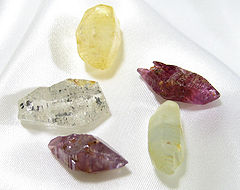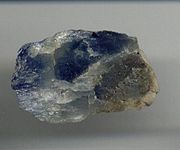
Sapphire curiosities
Sapphire curiosities
It is said that the blue sapphire, through time, after the diamond, has been one of the most sought-after and highly valued precious gems. It is important to know that both the sapphire and the ruby come from the mineral known as "corundum", a crystalline rock formation composed of aluminum oxide and parts of iron, chrome and titanium, depending on the impurities it contains, its color. There is a wide range of colors in corundum, green, yellow, pink and blue, called sapphire and red, better known as ruby.


Corundum
Historically, the blue sapphire has been an expression of love and devotion as well as a demonstration of power and opulence. At present it represents friendship, honesty, compatibility, mutual understanding, commitment and loyalty. There is also the belief that he protects whoever wears it. It is the stone of the month of September.
This gemstone is a tradition that continues to this day. As evidence, it is worth highlighting the sale in 2010, at the prestigious Christie's auction house in Hong Kong, of a spectacular platinum bracelet from Cartier (c.1960) with 9 Kashmir blue sapphires and diamonds that reached the sum of 6,915. $624.

World record sale at Christie's auction in 2010.
The central sapphire weighs 10.52ct. It is rare to find a piece of Kashmir Sapphires
that have not been treated and also, the nine stones with the same characteristics.
Blue sapphire deposits are widely distributed in a wide variety of geological conditions. This allows blue sapphire to be mined in larger quantities than any other color, with the occasional exception of yellow which is also found in large quantities.
Blue sapphires weighing hundreds of carats have been found, some famous specimens of this gem are found in museums such as the "Star Of India", a blue sapphire weighing 563.35ct.

“Star Of India” (Zafiro de 563,35ct)
The importance of the origin:
The origin of a gem has a great impact on its market value, such as the Burmese ruby, the Colombian emerald or the Brazilian tourmalines.
In the case of blue sapphires, those with the greatest reputation and value are those from Kashmir (very rare) and those from Burma. It is followed by Ceylon sapphires from Sri Lanka. Then the list continues successively in the following order of importance, value and quality:
- Kashmir.
- Burma.
- Ceylon.
- Madagascar (one of the largest producers of quality sapphires).
- Pakistan.
- Tanzania.
- Montana, USA
- Australia.
- Cambodia.
- China.
Some other countries with significant reserves of sapphires are Brazil, Colombia, Laos and Nigeria.
As with any colored gemstone, in addition to its origin, its value is influenced by color saturation, tone and, without a doubt, whether it is natural or treated. It can have a vivid and intense blue, violet blue or those of lesser value a blue with a minimal greenish hue.
The best quality Kashmir can fetch between $20,000 and $25,000 per carat. Today, the vast majority of colored stones are heat-treated or otherwise treated to enhance the appearance of their color, which is why its value is greatly increased when sapphire is natural.
Regardless of its origin, blue sapphire, whether natural or treated, continues to be the most sought-after color stone in jewelry.





Comments
Leave your comment